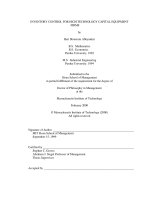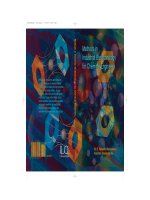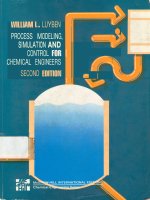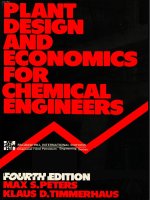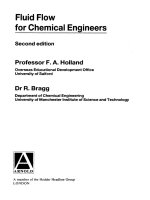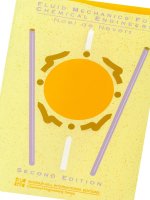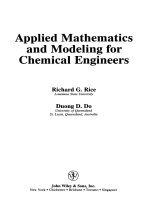essential process control for chemical engineers
Bạn đang xem bản rút gọn của tài liệu. Xem và tải ngay bản đầy đủ của tài liệu tại đây (17.64 MB, 208 trang )
DR. BRUCE POSTLETHWAITE
ESSENTIAL PROCESS
CONTROL FOR
CHEMICAL ENGINEERS
2
Essential Process Control for Chemical Engineers
1st edition
© 2017 Dr. Bruce Postlethwaite & bookboon.com
ISBN 978-87-403-1655-1
Peer reviewed by Dr. Iain Burns, Senior Lecturer, Director of Teaching, University of
Strathclyde
3
ESSENTIAL PROCESS CONTROL
FOR CHEMICAL ENGINEERS
CONTENTS
CONTENTS
Foreword
8
Introduction
9
Main Learning points
9
1.1
Why do we need control?
9
2
Instrumentation
12
Main learning points
12
2.1
What is an instrument?
12
2.2
Factors to be considered in selecting an instrument
13
2.3
Instruments for temperature measurement
17
2.4
Pressure measurement
20
2.5
Flow measurement
23
2.6
Level measurement
27
2.7
Chemical composition
30
1
www.sylvania.com
We do not reinvent
the wheel we reinvent
light.
Fascinating lighting offers an ininite spectrum of
possibilities: Innovative technologies and new
markets provide both opportunities and challenges.
An environment in which your expertise is in high
demand. Enjoy the supportive working atmosphere
within our global group and beneit from international
career paths. Implement sustainable ideas in close
cooperation with other specialists and contribute to
inluencing our future. Come and join us in reinventing
light every day.
Light is OSRAM
4
ESSENTIAL PROCESS CONTROL
FOR CHEMICAL ENGINEERS
3
CONTENTS
Communication signals
32
Main learning points
32
3.1
Types of communication signal
32
4
Final control elements
39
Main Learning points
39
4.1
Control valves
39
4.2
Control valve sizing
41
5
Diagrams for process control systems
48
Main learning points
48
5.1
Process flow diagrams (PFDs)
48
5.2
Piping and instrumentation diagrams (P&IDs)
49
6
Inputs and outputs in control systems
55
Main learning points
55
6.1
Process inputs
55
6.2
Process outputs
56
6.3
Processes in control engineering
57
6.4
An example of variables and processes
58
7
Introduction to feedback control
59
Main learning points
59
7.1
Feedback control and block diagrams
59
7.2
Positive and negative feedback
61
7.3
Control loop problems
61
7.4
Direction of control action
64
7.5
Controller hardware
66
8
Introduction to steady-state and dynamic response
70
Main learning points
70
8.1
Steady-state gain
70
8.2
Dynamic response
73
5
ESSENTIAL PROCESS CONTROL
FOR CHEMICAL ENGINEERS
9
CONTENTS
Dynamic modelling
87
Main learning points
87
9.1
Laplace transforms
88
9.2
Derivation of basic transforms
88
9.3
Solution of differential equations using Laplace transforms
91
9.4
Transfer functions
93
9.5
Block Diagrams
94
9.6
Block diagram algebra
95
9.7
Solutions of responses for high-order systems
95
9.8
Forming dynamic models
100
10
Analytical solution of real world models
106
Main learning points
106
10.1
Types of non-linearity
106
10.2
Linearisation of non-linear equations
107
10.3
Simplifying expressions through deviation variables
110
10.4
Procedure for simplifying and solving a non-linear model
112
10.5
Putting it all together – a reactant balance for a CSTR
112
11
PID Controller algorithm
117
Main learning points
117
11.1
Really simple feedback controller – on-off
118
11.2
Proportional-integral-derivative (PID) control
119
11.3
Proportional only control
121
11.4
Integral only control
126
11.5
Derivative action
127
11.6
Proportional-Intergral (PI) control
130
11.7
PID control response
131
11.8
Other forms of PID algorithm
133
12
Control system analysis
137
Main learning points
137
12.1
Analysis of a typical feedback control system
137
12.2
The PID algorithm as a transfer function
139
12.3
Analysis of proportional control of a first-order process
140
12.4
Example of a first order process under proportional control
142
12.5
Example of a second-order process under proportional control
145
12.6
Analysis of integral control of a first-order process
148
6
ESSENTIAL PROCESS CONTROL
FOR CHEMICAL ENGINEERS
CONTENTS
13
Controller tuning
149
Main learning points
149
13.1
What needs to be done to tune a PID Controller?
149
13.2
How do you decide what is a good controller performance?
150
13.3
Some methods of controller tuning
154
13.4
Control loop health monitoring
161
13.5
Control loop diagnostics
162
14
More advanced single-loop control arrangements
163
Main learning points
163
14.1
Cascade control
163
14.2
Selective or autioneering control
167
14.3
Override control
169
14.4
Ratio control
172
14.5
Feedforward control
173
15
Design of control systems
181
Main learning points
181
15.1
Control envelope
181
15.2
Multivariable processes
184
15.3
How to determine the number of controlled variables
185
15.4
Plantwide mass balance control
191
16
Control system architecture
194
Main learning points
194
16.1
The effect of technology on process plant control rooms
194
16.2
Human factors in control room displays
197
16.3
Distributed control systems
200
16.4
Safety Instrumented Systems
201
17
Bibliography
202
Acknowledgements
203
Appendix
204
The use of software for teaching process control at
Strathclyde University
204
7
ESSENTIAL PROCESS CONTROL
FOR CHEMICAL ENGINEERS
FOREWORD
FOREWORD
his book is based on the course notes from the introductory process control class at
Strathclyde University in Glasgow, Scotland. his course is itself based on the IChemE
model-curriculum for chemical engineers and covers the material that ALL chemical engineers
are supposed know. he IChemE curriculum was drawn up by a team of industrialists and
academics, led by Professor Jon Love, in response to a recognised need for chemical engineers
to be taught a more industrially relevant course.
his book isn’t a traditional academic textbook in that there are no references anywhere
in the text. he main reason for this is that the material has been gathered from many
diferent sources after a working lifetime of teaching in the area and trying to identify an
original source is impossible. I have included a bibliography for readers who wish to look
further into the subject.
I hope students and teachers ind this book useful. A major new part of the course at
Strathclyde University (where I teach) has been the introduction of new process control
learning software called PISim, and this is described in the appendix. PISim will be
commercially released in late Autum 2017.
8
ESSENTIAL PROCESS CONTROL
FOR CHEMICAL ENGINEERS
1
INTRODUCTION
INTRODUCTION
MAIN LEARNING POINTS
• Why process control is necessary
Process control is concerned with making sure that processes do what they are supposed
to in a safe and economical way. his isn’t an easy task as most processes are subject to
many inputs called disturbances that constantly cause the controlled variables to move
away from their desired values (or setpoints). To prevent this other process inputs called
manipulations have to be moved to restore the process to the desired state.
Process control is concerned with the overall system. A control engineer has to know about the
instruments used to measure process quantities, the valves and other inal control elements
that allow control systems to adjust the process, communications to transmit information
around, the control algorithms that decide how to respond to the information coming
from the process, and inally the control engineer needs to understand how the process
itself behaves: not just its steady-state behaviour but more importantly its dynamic response.
Control engineering is now an area which ofers big career opportunities for chemical
engineers. he area used to be dominated by electrical/electronic engineers as the major
challenges were in the hardware. his has changed. Sophisticated modern control systems
allow much more complicated, process related, control schemes and now a major
requirement for a control engineer is that they have a good understanding of the process.
1.1
WHY DO WE NEED CONTROL?
Figure 1 – a pressure trace from a SCADA system
9
ESSENTIAL PROCESS CONTROL
FOR CHEMICAL ENGINEERS
INTRODUCTION
• In real chemical plants, steady-state doesn’t exist. hings are always changing.
Temperatures move up and down, levels get lower and higher, etc (see igure 1).
• All processes are subject to disturbances. hese are inputs to the process that change
in a way that is beyond the reach of the local control system. A rainstorm on the
outside of a distillation column will cool the column and require action to be
taken to increase the heat input. Raw material variations are another common
disturbance. Actions of other control systems can also cause disturbances to the
process of interest – if a control system upstream or downstream of a process reduces
a lowrate its efects will cascade throughout the rest of the process.
• he control system needs to actively regulate against the efects of these disturbances.
It does this by either measuring the disturbances directly (where this is possible and
economic) or by measuring their efects on the controlled variables of the process. It
then makes adjustments to other inputs to the process called manipulated variables
to try to reduce or eliminate the efects of the disturbances. When controllers are
holding controlled variables at ixed setpoints they are said to be in regulator or
disturbance rejection mode.
• Process don’t suddenly start at their lowsheet conditions, they don’t shut down
on their own and don’t change production rate, etc without active intervention
from control systems. When these major changes are being made to a process, the
controllers will be acting in a setpoint tracking or servo mode. In servo mode, a
controller will be trying to make the controlled variable track a moving setpoint.
• Control systems also have a major part to play in process safety. he basic control
system will usually ensure that the process stays within acceptable limits and will
be equipped with alarms to warn operators of any problems. Interlocks may also
be present in the basic system. hese are used to lock particular inputs when other
conditions are in existence. For example, the access doors to a kiln may be locked
by a control system if the internal temperature is dangerously high. In extreme
circumstances, special control systems (called safety instrumented systems or SIS ) that
are separate from the normal process control system may come into play. hese
may be local to a particular piece of equipment, for example a high-temperature
trip on a pump motor; or may have a process or plant-wide focus, for example an
emergency shutdown system.
10
ESSENTIAL PROCESS CONTROL
FOR CHEMICAL ENGINEERS
INTRODUCTION
• Finally, good control saves money. Plants are normally operated close to constraints
(e.g. the acceptable product quality). Poor control means more variability and
this means that the mean value of a controlled variable needs to be held further
from the constraint than is necessary with good control. Figure 2 shows a simple
example – the tops quality from a distillation column. his may have a limit on
the lowest acceptable composition and it’s the responsibility of the control system
to hold the composition about this limit. If the control is poor and there’s lots of
variability, then it will be necessary to set an average value of composition much
higher than if good control is used. his higher average composition will lead to
increased relux going down the column and hence more vapour having to be
generated by the reboiler, which increases steam costs.
Figure 2 – The advantage of good control
11
ESSENTIAL PROCESS CONTROL
FOR CHEMICAL ENGINEERS
2
INSTRUMENTATION
INSTRUMENTATION
MAIN LEARNING POINTS
• Factors involved in selecting instrumentation
• Techniques for temperature, pressure, low and level measurements
he instruments on a chemical plant are the devices used to monitor the important variables
that allow the condition of the process to be determined.
2.1
WHAT IS AN INSTRUMENT?
Transducers or sensors are the primary sensing elements. hey are devices that convert some
physical quantity that we want to measure (e.g. temperature, pressure, etc). into some sort
of signal that can be processed further. For example, a thermocouple converts a temperature
diference into a voltage; a piezo resistive pressure sensor converts a pressure into a change
in electrical resistance.
360°
thinking
.
Discover the truth at www.deloitte.ca/careers
12
© Deloitte & Touche LLP and affiliated entities.
ESSENTIAL PROCESS CONTROL
FOR CHEMICAL ENGINEERS
INSTRUMENTATION
Signal conditioning is the signal processing that is applied to the output of the transducer.
Sometimes this could simply be ampliication, but often more complicated things like
linearisation are required (ideally, the output of a device should change linearly with changes
in the quantity being measured). Modern instruments such as Coriolis lowmeters have very
complicated signal processing build into them to detect the phase shifts in the motion of
the sensing elements.
A transmitter is a device that converts the output from signal conditioning into a signal
that is compatible with the communication system being used in the plant. here are many
diferent standards in use ranging from 4-20mA analogue signals up to digital Fieldbus
systems – these will be discussed later.
An instrument is a device that contains at least one but usually more, and often all of
the above (transducer, signal conditioning and transmitter). An instrument is a complete
measurement package that senses the quantity to be measured and presents that measurement
in a form suitable for use (e.g. a simple instrument might be a Bourdon gauge for pressure
measurement – the transducer, a helical metal tube, distorts with pressure and drives the
gauge needle directly; a more typical instrument for modern chemical plants might be a
packaged RTD (resistance temperature device) – it will include the RTD, signal conditioning,
and a transmitter).
2.2
FACTORS TO BE CONSIDERED IN SELECTING AN INSTRUMENT
2.2.1 RANGE
he range of an instrument is range of the measured quantity over which the instrument
will give a reliable output. he range is always the same or bigger than the span of an
instrument. While an instrument with a large range might seem to be always desirable this
isn’t usually the case in practice. he sensitivity (change in output vs change in measurement)
of transducers drops signiicantly in large range devices leading to reduced accuracy.
2.2.2 SPAN
he span of an instrument is an adjustable parameter (there will be a button, screw or
software link on the instrument that will allow the adjustment). he span is the distance
the measured quantity has to move to drive the instrument output from its minimum value
to its maximum (remember that instrument outputs match communication standards which
have ixed maximum and minimum values). By adjusting the span, the instrument’s sensitivity
(output change vs. input change) can be altered – large spans will lead to lower sensitivities.
13
ESSENTIAL PROCESS CONTROL
FOR CHEMICAL ENGINEERS
INSTRUMENTATION
2.2.3 ACCURACY AND PRECISION
All measurement instruments are subject to random error – if you take repeated measurements
of a ixed quantity you will always get a scatter of values about a mean. An accurate
instrument is one where the mean is centred close to the actual value of the quantity being
measured. An instrument can be accurate, but still have a signiicant amount of error on an
individual measurement – the accurate mean can only be obtained by taking many repeat
measurements. A precise instrument is one which, when measuring a constant quantity,
returns output values which are very close to one another – the scatter between readings
is small. It is possible for an instrument to be precise (high repeatability in measurement)
but not accurate (with the mean some distance away from the true value of the quantity
being measured). An ideal instrument is one which is both precise and accurate.
Figure 3 – accuracy and precision
2.2.4 REPEATABILITY AND DRIFT
In most instruments repeatability and precision mean the same thing. However, some sensors
sufer from hysteresis. In these sensors the measurement is afected by what the variable being
measured was doing prior to the measurement. It is most prevalent in systems which involve
some sort of mechanical element in their sensing. For example, bourdon pressure sensors
usually exhibit hysteresis – the measurement they produce will be diferent if the pressure
was rising or falling immediately prior to the measurement.
Drift is a medium to long term efect that causes some instruments to lose mainly accuracy, but
also possibly precision. For example, corrosion of a thermocouple will alter its thermoelectric
properties and hence the voltage produced at a particular temperature.
14


